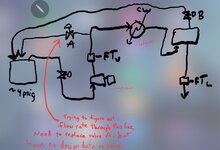So I'm new to the oil and gas field, having been in more of a non-technical and unrelated industry for the past 20+ years. So, I'm pretty rusty!
I have a M&E balance for hydrocarbon stream where I'm trying to confirm the calculations to convert a vapor stream to nominal liquid barrels/day. The reason is I'm trying to do a mass balance on a spill back line off the vapor line and my partial output is in barrels after condensing the vapor stream.
The mixture is mostly isobutane, so will just assume 100% to simplify.
Vapor phase:
T = 151.8°F
P = 99 psia
Mol Wt. = 56.23 g/mol
Mass flow = 146,262 lb/hr
Is this as simple as saying that the density of isobutane at 60°F is 563 kg/m3 -> 563 kg/m3 * 2.2 lb/kg / 264.17 gal/m3 * 42 gal/barrel -> 196.92 lb/barrel
Then 146,262 lb/hr * 24 hr/day / 196.92 lb/barrel --> 17,826 barrel/day
Am I missing anything?
I have a M&E balance for hydrocarbon stream where I'm trying to confirm the calculations to convert a vapor stream to nominal liquid barrels/day. The reason is I'm trying to do a mass balance on a spill back line off the vapor line and my partial output is in barrels after condensing the vapor stream.
The mixture is mostly isobutane, so will just assume 100% to simplify.
Vapor phase:
T = 151.8°F
P = 99 psia
Mol Wt. = 56.23 g/mol
Mass flow = 146,262 lb/hr
Is this as simple as saying that the density of isobutane at 60°F is 563 kg/m3 -> 563 kg/m3 * 2.2 lb/kg / 264.17 gal/m3 * 42 gal/barrel -> 196.92 lb/barrel
Then 146,262 lb/hr * 24 hr/day / 196.92 lb/barrel --> 17,826 barrel/day
Am I missing anything?

